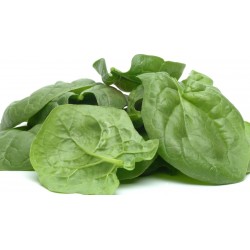Menu
-
MenuНазад
- Home
-
Категории
-
-
Категории
-
Растительные Семена
-
Сорта по стране
- Сорта из Армении
- Сорта из БиГ
- Сорта из Хорватии
- Сорта из Франции
- Сорта из Германии
- Сорта из Греции
- Сорта из Венгрии
- Сорта из Индии
- Сорта из Италии
- Сорта из Японии
- Сорта из Северной Македонии
- Сорта из Перу
- Сорта из россии
- Сорта из Сербии
- Сорта из Словении
- Сорта из Испании
- Сорта из Тайланда
- Сорта из Турции
- Сорта из США
- Семена томатов
- Семена кукурузы
- Семья тыквы
- Бобовая семья
- Семена огурца
- Семена перца
- Морковная семья
- Луковая семья
- Семена салата
- Картофельная семья
- Капустная семья
- Семена редьки
- Семья свеклы
- Семена Aрбуза
- Семена Дыни
- Цветная капуста Семена
- Подсолнечное семейство
-
Сорта по стране
- Фруктовые Семена
- Семена Перец Чили - Habanero
- Лекарственные травы Семена
- Вьющиеся растения семена
- Деревья Бонсай Семена
- Пальмовые семена
- Семена декоративных трав
- Семена табака
-
Растительные Семена
-
-
-
-
- НОВЫЕ ПРОДУКТЫ
- Доставка - Оплата
- Регистрация
- FAQ
- Главная
-
- Растительные Семена
- Сорта по стране
- Сорта из Северной Македонии
- Сорта из Хорватии
- Сорта из Турции
- Сорта из БиГ
- Сорта из Японии
- Сорта из Индии
- Сорта из Армении
- Сорта из Франции
- Сорта из Словении
- Сорта из Сербии
- Сорта из Греции
- Сорта из россии
- Сорта из Италии
- Сорта из Испании
- Сорта из США
- Сорта из Германии
- Сорта из Перу
- Сорта из Тайланда
- Сорта из Венгрии
- Цветная капуста Семена
- Семена Дыни
- Семена Aрбуза
- Подсолнечное семейство
- Семья свеклы
- Семена редьки
- Семена томатов
- Семена кукурузы
- Семья тыквы
- Бобовая семья
- Семена огурца
- Семена перца
- Капустная семья
- Картофельная семья
- Луковая семья
- Семена салата
- Морковная семья
- Сорта по стране
- Упаковка и прочее
- Грибной мицелий
- Завод Луковицы
- Органические специи
- Аюрведические растения
- Гибридные семена F1
- Семена банана
- Нет PayPal и оплаты картой X
- Семена гигантских растений
- Морозостойкие растения
- Семена бамбука
- Фруктовые и овощные формы
- Большие пакеты семян
- Фруктовые Семена
- Семена Перец Чили - Habanero
- Лекарственные травы Семена
- Вьющиеся растения семена
- Деревья Бонсай Семена
- Пальмовые семена
- Семена декоративных трав
- Семена табака
- Доставка - Оплата
- Инструкция по посеву
- Уход за растениями
- Семена водных растений
- Семена кактуса
- Семена цветов
- Растительные Семена
Последние отзывы к продукту
These peppers came all the way from eastern Europe and took a while at no f...
От
 Fitim Berani на 21/09/2023
Fitim Berani на 21/09/2023
Проверенная покупка
Last customers
- Tanja, Beograd, Serbia
- Alaa, Alwajh, Saudi Arabia
- ionescu, valu lui traian, Romania
- Lasse, 2900, Norway
- Pete, Cleves, United States
- Stef, Waalwijk, Netherlands
- Sonia, Minervino di Lecce, Italy
- Adrian, Ingolstadt, Germany
- CORINNE, NOTRE DAME DE LONDRES, France
- Dušan, KRAVANY NAD DUNAJOM, Slovakia
- Arno, Ehrenkirchen, Germany
- Costas, LARNACA , Cyprus
- Fulvio francesco, Santa Domenica Talao, Italy
- william, Dun, France
- Aymeric , Saint tricat, France
- Ricard, Sant Celoni, Spain
- Maureen , Enniscorthy Co Wexford , Ireland
- Paul, St. Vigil in Enneberg (BZ), Italy
- Ricardo jorge , Viseu , Portugal
- Radosav, Kragujevac, Serbia
- Sylvie, Neyruz, Switzerland
- Julien, Scionzier, France
- Zoran, Vinca, Serbia
- Josef, Hochdorf-Assenheim, Germany
- Davide, London, United Kingdom
- Kimberly, Victoria, Gozo, Malta
- Saša , Beograd, Serbia
- Ewa, Galway, Ireland
- Ioannis , Kato Achaia, Greece
- Samuele, Milano, Italy
Лидеры продаж
Товаров: 882.
Показано 409-420 из 882
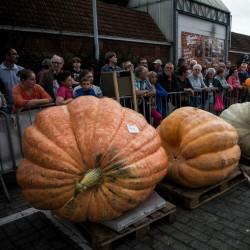
BIG MAX Pumpkin Heirloom Seeds
Цена
4,95 €
SKU: VG 51
Seeds Gallery Com,
5/
5
<!DOCTYPE html>
<html>
<head>
<meta http-equiv="Content-Type" content="text/html; charset=UTF-8" />
</head>
<body>
<h2><strong><em><span style="text-decoration: underline;">BIG MAX Pumpkin Heirloom Seeds</span></em></strong></h2>
<h3><span style="color: #ff0000;"><strong>Price for Package of 4 seeds.</strong></span></h3>
<p>(C. maxima) 110 days Huge pumpkins can grow well over 50 kg - 100 lbs! Nearly round, bright orange fruit are stunning and are good for pies and canning. Very thick, orange flesh. Good for county fairs and displays.</p>
<p><strong>GARDIN HINTS:</strong> Let one or two pumpkins only develop per vine for largest size.</p>
</body>
</html>
VG 51 (4 S)


Variety from Peru

This plant is edible
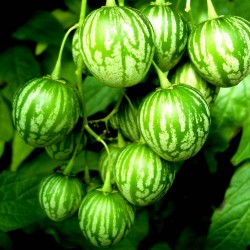
Дикий Пепино - Тзимбало...
Цена
4,00 €
SKU: V 213
Seeds Gallery Com,
5/
5
<meta http-equiv="Content-Type" content="text/html; charset=UTF-8" />
<h2><strong>Дикий Пепино - <b>Тзимбало</b> Семена (Solanum Caripense)</strong></h2>
<h2><span style="color: #ff0000;"><strong>Цена за пакет из 5 семян.</strong></span></h2>
<p>Solanum caripense - Цимбало - это разновидность вечнозеленого кустарника, произрастающего в Южной Америке и выращиваемого для его вкусных съедобных фруктов.</p>
<p>Цимбало - травянистый куст с темно-зелеными листьями, высота которых достигает 30-50 см. Плод очень похож на плод родственного Pepino, и предполагается, что Solanum caripense является диким предком Pepino. Как и Пепино, Цимбало является родственником других соланумов, выращенных для его съедобных фруктов, включая томаты (S. licopersicum), наранхиллу (S. kuitoense) и баклажаны (S. melongena).</p>
<p>Цимбало выращивается на родине в Колумбии, Эквадоре, Боливии, Перу и Чили, но в небольших масштабах был вновь открыт другими садоводами в мире. Считается, что Цимбало родом из Андских регионов Колумбии, Перу и Чили. Как и Пепино, Цимбало может приносить плоды в течение одного или двух лет от семени.</p>
<p>Плоды круглые, размером до 2 см, от зрелого до желтого или бледно-зеленого цвета с продольными полосками темного цвета. Вкус и текстура, хотя и похожи на пепин, плоды Цимбало намного сочнее. Как и Пепино, Цимбало ведет себя лучше всего в теплом, относительно холодном климате. Растение может выдерживать низкую температуру -2,5 ° C (27-28 ° F), если период замораживания короткий.</p>
<p>Цимбало хорошо приспособлен для выращивания в теплице. Как и большинство съедобных соланумов.</p>
V 213 (10 S)

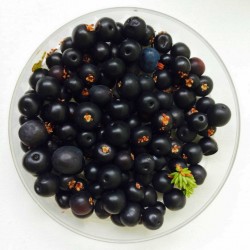
Водяника чёрная, Шикша...
Цена
1,95 €
SKU: V 212
Seeds Gallery Com,
5/
5
<h2><strong>Водяника чёрная, Шикша чёрная, Вороника чёрная семена</strong></h2>
<h2><span style="color:#ff0000;"><strong>Цена за пакет из 5 семян.</strong></span></h2>
<p><b>Водяника чёрная</b>, или<span> </span><b>Шикша чёрная</b>, или<span> </span><b>Вороника чёрная</b><span> </span>(лат. <span lang="la" xml:lang="la">Empetrum nigrum</span>) —<span> </span>вид<span> </span>двудольных растений<span> </span>рода<span> </span>Водяника<span> </span>(<i><span lang="la" xml:lang="la">Empetrum</span></i>) семейства<span> </span>Вересковые<span> </span>(<i><span lang="la" xml:lang="la">Ericaceae</span></i>). Таксономическое название впервые опубликовано шведским систематиком<span> </span>Карлом Линнеем<span> </span>в 1753 году.<span> </span>Типовой вид<span> </span>своего рода.</p>
<p>Как правило, водяника чёрная считалась единственным видом водяник<sup id="cite_ref-6" class="reference">[6]</sup>, однако сейчас в ряде классификаций в составе рода Водяника выделяется от 3—4<sup id="cite_ref-7" class="reference">[7]</sup>до 18<sup id="cite_ref-8" class="reference">[8]</sup><span> </span>видов.</p>
<h2><span></span><span class="mw-headline">Распространение и среда обитания</span></h2>
<p>Распространена в ряде<span> </span>европейских<span> </span>стран (включая<span> </span>Россию, где она известна от европейской части до<span> </span>Западной Сибири), в<span> </span>Азии<span> </span>(Китай,<span> </span>Монголия,<span> </span>Корейский полуостров) и в<span> </span>Северной Америке<span> </span>(Канада,<span> </span>США,<span> </span>Сен-Пьер и Микелон)<sup id="cite_ref-9" class="reference">[9]</sup>.</p>
<p>Встречается на сфагновых болотах, на каменистых участках, в лесах (светлохвойных и тундровом редколесье), в щебнистых тундрах и на дюнах<sup id="cite_ref-plantarium_2-1" class="reference">[2]</sup>.</p>
<p>Обширные заросли водяники — вороничники, или вороничная тундра — характерны для островов мурманского побережья Баренцева моря и безлесных островов Белого моря (луд)<sup id="cite_ref-10" class="reference">[10]</sup><span></span><sup class="noprint">[<i><span title="утверждение не найдено в указанном источнике (6 сентября 2015)">нет в источнике</span></i>]</sup>.</p>
<h2><span></span><span class="mw-headline">Ботаническое описание</span></h2>
<div class="thumb tleft">
<div class="thumbinner"><img alt="" src="https://upload.wikimedia.org/wikipedia/commons/thumb/2/29/Empetrum_nigrum_Sturm22.jpg/220px-Empetrum_nigrum_Sturm22.jpg" width="220" height="321" class="thumbimage" /><div class="thumbcaption">
<div class="magnify"></div>
Ботаническая иллюстрацияЯкоба Штурма<span> </span>из книги<span> </span><i>Deutschlands Flora in Abbildungen</i>, 1796</div>
</div>
</div>
<p>Вечнозелёный кустарничек<sup id="cite_ref-plantarium_2-2" class="reference">[2]</sup>.</p>
<p>Ветви железистые или голые, зелёного, коричневого или красноватого цвета<sup id="cite_ref-efloras_11-0" class="reference">[11]</sup>.</p>
<p>Листья простые, кожистые, размещены очерёдно по длине стебля<sup id="cite_ref-plantarium_2-3" class="reference">[2]</sup>.</p>
<p>Цветки однополые или обоеполые, с зеленовато-розовыми и красновато-фиолетовыми чашелистиками<sup id="cite_ref-efloras_11-1" class="reference">[11]</sup>.</p>
<p>Плод — чёрная непрозрачная костянка со светло-коричневыми семенами<sup id="cite_ref-efloras_11-2" class="reference">[11]</sup>.</p>
<p>Цветёт весной<sup id="cite_ref-efloras_11-3" class="reference">[11]</sup>.</p>
<h2><span></span><span class="mw-headline">Хозяйственное значение и применение</span></h2>
<p>Лекарственное и пищевое растение<sup id="cite_ref-plantarium_2-4" class="reference">[2]</sup>.</p>
<p>Плоды содержат до 70 мг%<span> </span>витамина С. Употребляются в пищу свежими, в массе заготавливаются на зиму в мороженом или мочёном виде. В зимнем рационе северян неизменно присутствует блюдо «толкуша», представляющее собой смесь ягод водяники, измельчённой рыбы и тюленьего жира. Из ягод можно варить варенье, делать<span> </span>мармелад, напитки, но с добавлением большого количества сахара<sup class="reference">[12]</sup>.</p>
<p>Соком ягод можно окрашивать в вишнёвый цвет шерсть и кожу, они служат кормом куропаткам и другим птицам, весной их едят медведи и олени.</p>
<p>В народной медицине ягоды употребляются как мочегонное; настоями побегов лечат различные заболевания<sup class="reference">[12]</sup>.</p>
<h2><span></span><span class="mw-headline">Природоохранная ситуация</span></h2>
<p>Занесена в Красные книги ряда регионов России: Ивановской, Калужской, Кировской, Костромской, Липецкой, Московской, Нижегородской, Рязанской, Смоленской, Тверской, Тульской, Ярославской областей, республик Марий Эл, Татарстан и Удмуртия.<span></span></p>
V 212


This plant is resistant to winter and frost.
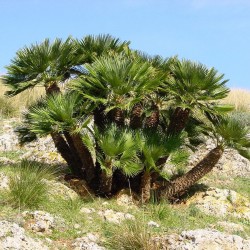
Mediterranean dwarf palm...
Цена
3,00 €
SKU: PS 9
Seeds Gallery Com,
5/
5
<h2><span style="font-size:14pt;"><strong>European fan palm, Mediterranean dwarf palm Seeds (Chamaerops humilis)</strong></span></h2>
<h2><span style="color:#ff0000;font-size:14pt;"><strong>Price for Package of 3 seeds.</strong></span></h2>
<p>Chamaerops is a genus of flowering plants in the palm family Arecaceae. The only currently fully accepted species is Chamaerops humilis, variously called European fan palm, or the Mediterranean dwarf palm. It is one of the more cold-hardy palms used in landscaping in temperate climates.</p>
<p>Chamaerops humilis is a shrub-like clumping palm, with several stems growing from a single base. It has an underground rhizome which produces shoots with palmate, sclerophyllous leaves.</p>
<p>The stems grow slowly and often tightly together, eventually reaching 2–5 m (10–20 ft) tall with a trunk diameter of 20–25 cm (8–10 in). It is a fan palm (Arecaceae tribe Corypheae), and as such, has leaves with petioles terminating in rounded fans of 10–20 leaflets. Each leaf is up to 1.5 m (5 ft) long, with leaflets 50–80 cm (20–30 in) long. The petioles are armed with numerous sharp, needle-like spines; these may protect the stem growing point from browsing animals.</p>
<p>The flowers are borne in dense, short inflorescences at the tops of the stems. The plants usually, but not invariably, are dioecious with male and female flowers on separate plants. The prophyll covers the flowers on the inflorescence until the sexual phase (anthesis) and then splits open apically into two triangular lobes. The number of flowers per inflorescence is highly variable for both male and female plants, depending on the size of the inflorescence. Female flowers are tri-ovulate.[6] Unripe fruits are bright green, turning to dull yellow to brown as they ripen during autumn (September–November). The seed (usually 0.6–0.8 g or 1⁄50–3⁄100 oz) contains a small cylindrical embryo, which is surrounded by several layers, from inner to outer as follows:</p>
<p>a nutritious endosperm,</p>
<p>a wide woody layer or endocarp,</p>
<p>a fleshy and fibrous mesocarp (the pulp), and</p>
<p>the thin outer layer or exocarp.</p>
<p><strong>Taxonomy</strong></p>
<p>Apart from the fully accepted Chamaerops humilis there currently are a few species of unresolved status plus tens of species synonymised with Chamaerops humilis.</p>
<p>The species Chamaerops humilis itself has three accepted varieties as follows:</p>
<p>Chamaerops humilis var. argentea André (syn. C. h. var. cerifera) – "Atlas mountain palm" of Northwest Africa. Leaves glaucous.</p>
<p>Chamaerops humilis var. epondraes – Northwest Africa. Leaves glaucous.</p>
<p>Chamaerops humilis var. humilis – Southwest Europe. Leaves green.</p>
<p>There also are at least three cultivars (C. humilis var. humilis 'Nana', C. humilis 'Vulcano', C. humilis 'Stella'). C. humilis 'Vulcano' is a compact, thornless cultivar. May be silvery, but less so than argentea. The leaves tend to be thicker, and the appearance of the plant is bushier than var. humilis or var. argentea.</p>
<p>The genus Chamaerops is closely related to the genus Trachycarpus. The genera differ in that Trachycarpus lacks the clumping habit only forms single stems without basal suckers), the spiny leaf stems (spineless in Trachycarpus), and in small details of the flower anatomy.</p>
<p><strong>Distribution</strong></p>
<p>Chamaerops humilis is one of only two palm species native to southern Europe, the other being Phoenix theophrasti. It is mainly found in southwestern Europe (Malta, Sicily, over all the Mediterranean coast of Spain and Portugal, central and southern Italy, some parts of the southern Mediterranean coast of France and Monaco, as well as northwest Africa (Morocco, Algeria, Tunisia). It is the northernmost naturally occurring palm in the world, with the northernmost standing at Hyères-les-Palmiers, at 43° 07′ N.</p>
<p><strong>Cultivation</strong></p>
<p>Chamaerops humilis is valued in gardening and landscaping in many parts of the world. It is very drought-tolerant once established.</p>
<p><strong>It is hardy to −12 °C (10 °F), but does prefer hot summers. </strong></p>
<p>It is a very slow-growing plant. The blue form of the species, native to high elevations of the Atlas Mountains, has recently been introduced into the trade and early reports indicate that it may be −12 °C (−22 °F) or more degrees hardier than the green form.</p>
<p>It has gained the Royal Horticultural Society's Award of Garden Merit.</p>
<p><strong>Ecology and interactions with animals</strong></p>
<p>Chamaerops humilis flowers in spring, typically from April to May. The plant also may be partly anemophilous, that is to say, wind-pollinated, but it is at least partly entomophilous, that is to say dependent on pollination by insects. Only one insect species is known to pollinate it, namely a specific weevil, Derelomus chamaeropsis in the family Curculionidae.[13] The nature of the relationship with the weevil is a version of nursery pollination mutualism with the weevil; the form this takes is that once pollinating weevils have found a satisfactory plant, whether male or female, they usually stay on the same plant until the end of its anthesis, finding shelter, egg-laying sites, and food in the inflorescences.</p>
<p>At anthesis, as is common in Angiosperms, both male and female Chamaerops humilis plants attract their pollinators with chemical compounds, but an unusual feature is that their scents are released by the leaves, and not by the flowers.[15] Towards the end of anthesis, weevils leave the plant and seek a new host plant, again either male or female.</p>
<p>Larval development of the weevil Derelomus chamaeropsis occurs within rachises of inflorescences of male plants during autumn and winter. At the beginning of the next flowering period, adult weevils emerge from the dry and brittle stems of old inflorescences of the previous year of male plants only. Those that hatch in female plants die without concluding their development. This is because the palmettos are adapted to prevent the pollinating weevils from destroying the female inflorescences with their burden of seed. Weevils have been shown to lay eggs within female inflorescences, but as soon as seeds start to develop, eggs or larvae fail to continue their life cycle. On the other hand, male inflorescences have completed their function after pollination, so it is advantageous to the plant's reproduction for the weevils to complete their life cycles and shelter in the male inflorescences, thereby remaining available for pollination when they emerge in the following season.</p>
<p>The ripe pulp of C. humilis has several important functions.</p>
<p>When ripened, the pulp smells strongly of rancid butter[18] and thus acts as a foraging cue for nocturnal frugivores that commonly are fundamentally carnivorous mammals such as badgers and foxes.</p>
<p>The pulp inhibits germination, ensuring that the seed does not germinate until has been dispersed.</p>
<p>The pulp also acts as a chemical or physical barrier against invertebrate seed predators, typically beetles, and in particular weevils.</p>
<p>Because of the combination of such functions in the pulp, the palm both benefits and suffers adverse consequences when carnivores feed on the fruit and thereby remove the pulp. On the one hand, the seeds that carnivores swallow, germinate more frequently than seeds in entire fruit. On the other hand, ingested seeds are more frequently destroyed by invertebrate pests than non-ingested seeds. However, because of the mobility of carnivores, their dispersal service is important to the palmetto, given the severe fragmentation and isolation of most populations across the increasingly densely populated Mediterranean basin.</p>
<p><strong>Uses and threats</strong></p>
<p>Chamaerops humilis has a wide distribution in uncultivated land, and it is adapted to regimes of frequent burning, which it survives largely by re-sprouting from underground rhizomes and from fire-damaged stems. Such factors make the species ecologically important in preventing erosion and desertification and in providing shelter and food to many species of animals.</p>
<p>Apart from its material benefits, this palmetto is of emotional value as a charismatic component of the "garrigues" and "macchias" of the Mediterranean coastline.</p>
<p>The leaves of the adult plants have been used to make brooms and for weaving mats, carrier baskets, and similar articles. For finer work the young, unopened leaves are treated with sulphur to soften them softer and provide supple fibre.</p>
<p>The husk, known in southern Spain as "higa", is edible before it becomes too tough to eat as it matures. Because of their bitterness and high tannin content, the fruit are not used for human food, but in traditional medicine they have been used as an astringent.[19]</p>
<p>Urbanization and other human activities are making such rapid inroads into the natural habitat of palmetto that they are raising concerns about its future and that of its environment. Accordingly there is an increase in regulations to protect both its stands and those of associated Mediterranean endemics.</p>
<p>Another conservation problem is that particularly in the northernmost parts of its natural range, Chamaerops humilis is seriously threatened by an introduced South American moth Paysandisia archon.[9][20] Also, this Mediterranean native palm is affected by the introduction of related ornamental species because of the concurrent introduction of seed predators (such as Coccotrypes dactyliperda and Dactylotrypes longicollis) that feed on both the introduced and native palms.</p>
PS 9 (3 S)

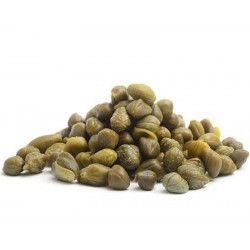
Семена Каперсы колючие...
Цена
1,95 €
SKU: VE 10
Seeds Gallery Com,
5/
5
<h2><strong>Семена Каперсы колючие (Capparis spinosa)</strong></h2>
<h2><span style="color:#ff0000;"><strong><span class="tlid-translation translation" lang="ru" xml:lang="ru"><span title="">Цена за пакет из 10 семян.</span></span></strong></span></h2>
<p><b>Каперсы колючие</b> (лат. <span style="font-style:italic;" lang="la" xml:lang="la">Capparis spinosa</span>) — травянистое растение; типовой вид рода Каперсы (<i><span lang="la" xml:lang="la">Capparis</span></i>) семейства Каперсовые. Овощная культура: маринуют нераспустившиеся цветочные бутоны, в которых содержатся белки, масло, витамины. Дикорастущие каперсы в кулинарных целях используют в Европе, Северной Африке, Северной Америке, Индии и в Дагестане.</p>
<h2><span></span><span class="mw-headline">Ботаническое описание</span></h2>
<div class="thumbinner" style="width:222px;"><img alt="" src="https://upload.wikimedia.org/wikipedia/commons/thumb/4/47/Capparis_spinosa_Blanco1.179.png/220px-Capparis_spinosa_Blanco1.179.png" class="thumbimage" width="220" height="322" /><div class="thumbcaption">
<div class="magnify"></div>
</div>
</div>
<div class="thumb tleft">
<div class="thumbinner" style="width:222px;">
<div class="thumbcaption">Ботаническая иллюстрация из книги Франсиско Мануэля Бланко <i>Flora de Filipinas</i>, <span class="nowrap">1880—1883</span></div>
</div>
</div>
<p>Многолетнее травянистое растение с мощной корневой системой.</p>
<p>Стебли стелющиеся, длиной до 1,5 м.</p>
<p>Листья округлые, обратнояйцевидные, с колючими прилистниками и короткими черешками. Листорасположение очерёдное.</p>
<p>Цветки одиночные, 5—8 см в диаметре, с белыми, розовыми или желтоватыми лепестками, расположены в пазухах листьев на длинных цветоножках. Чашечка и венчик четырёхчленные, тычинок много, пестик один, с завязью на длинной (3—5 см) ножке. Цветёт с мая до осени.</p>
<p>Плоды — продолговатые, 2—4 см длиной, мясистые ягодообразные многосемянные коробочки, зелёные снаружи, ярко-красные внутри, с бурыми семенами. Созревание плодов растянуто с июня до октября.</p>
<p>Опыляется насекомыми. Размножается семенами. В распространении семян главную роль играют животные. Плодоношение наступает на пятый год<sup class="reference">[2]</sup>.</p>
<p>Продолжительность жизни особи — более 50 лет<sup class="reference">[2]</sup>.</p>
<h2><span></span><span class="mw-headline">Распространение и среда обитания</span></h2>
<p>Растёт в Крыму, на Кавказе, в Казахстане и Средней Азии.</p>
<p>Встречается в глинистых и каменистых пустынях, в нижних поясах гор, на щебнистых россыпях, развалинах построек. Переносит засоление.</p>
<p>Глубоко идущие длинные корни позволяют растению переживать продолжительные засухи и высокую температуру<sup class="reference">[2]</sup>.</p>
<div class="thumb tleft">
<div class="thumbinner" style="width:252px;"><img alt="" src="https://upload.wikimedia.org/wikipedia/commons/thumb/7/76/Caper_flowers_20180530.jpg/250px-Caper_flowers_20180530.jpg" class="thumbimage" width="250" height="333" /><div class="thumbcaption">
<div class="magnify"></div>
</div>
</div>
</div>
<div class="thumb tleft">
<div class="thumbinner" style="width:252px;">
<div class="thumbcaption">Цветы каперса колючего</div>
</div>
</div>
<h2><span></span><span class="mw-headline">Хозяйственное значение и применение</span></h2>
<p>Пищевое растение, возделывается.</p>
<p>В кулинарии (особенно в средиземноморской, итальянской, испанской, французской кухнях) используются нераспустившиеся цветочные бутоны, а также плоды растения<sup class="reference">[3]</sup>.</p>
<p>Бутоны сортируют по размеру, подвяливают в течение ночи, а затем солят, маринуют, иногда консервируют в уксусе и растительном масле. Считается, что мелкие каперсы имеют более нежный, а крупные — более пряный вкус. Иногда перед приготовлением солёные каперсы предварительно вымачивают, промывают или ошпаривают для удаления избытков соли<sup class="reference">[3]</sup>. Вкус пикантный, островатый, слегка терпкий, кисловатый, немного горчичный. Имеют сильный аромат благодаря горчичному маслу, которое появляется при растирании стебля растения.</p>
<p>Спелые плоды каперсового куста можно употреблять сырыми. Они представляют собой стручковидные ягоды с красноватой мякотью, похожи на маленькие полосатые огурчики — капперони<sup class="reference">[3]</sup>. В них содержится около 18 % белковых веществ, до 30 % масла в семенах, около 0,32 % рутозида в бутонах.</p>
<p>На территории бывшего СССР культивируется на Северном Кавказе, в Закавказье, Средней Азии и Крыму. В Крыму каперсник обычен на бесплодных сланцевых скалах Южного берега от Балаклавы до Феодосии.</p>
<p>Цветочные бутоны, сорванные до полного распускания, замаринованные в уксусе, и являются теми <i>каперсами</i>, ради которых это растение выращивают в культуре. Маринованные бутоны употребляют как пряную приправу. В них содержится 21—29 % белковых веществ, 3,8—4,6 % жира, 0,32 % рутина, 150 мг% аскорбиновой кислоты, эфирное масло, пектин и другие полезные для организма соединения<sup class="reference">[2]</sup>. На Кавказе бутоны собирают как для местного употребления, так и для производства консервов.</p>
<p>Плоды едят свежими; раньше их сушили и употребляли зимой вместо сахара. Мякоть их очень сладкая (до 12 % сахаров), сходна по вкусу с арбузом. В семенах до 18 % белка и 25—36 % полувысыхающего жирного масла, пригодного для пищевого использования<sup class="reference">[2]</sup>.</p>
<p>Используют каперсы и в народной медицине. Свежие части каперсов обладают мочегонным, антисептическим и обезболивающим свойствами. Плоды используют при заболеваниях щитовидной железы, геморрое, болезнях дёсен и зубной боли. Соком каперсов лечат незаживающие раны, а настоем и отваром молодых листьев и побегов каперсника — сахарный диабет. Кору свежих корней растения жуют при заболеваниях полости рта и зубной боли. Отвар коры корней употребляют при ипохондрии, истерических припадках, параличе, болезнях селезёнки и при простудной и ревматической ломоте<sup id="cite_ref-4" class="reference">[4]</sup>. В состав каперсов входит рутин, поэтому их применяют при повышенном артериальном давлении. Отвар цветков, коры и корней каперсника используют для улучшения сердечной деятельности, при болях разного характера и неврозах.</p>
<p>На Кавказе иногда употребляют как приправу и холодную закуску квашеные молодые ветви с цветками<sup class="reference">[2]</sup>. В некоторых рецептах вместо каперсов могут использоваться недозрелые зелёные завязи плодов настурции. Кавказские джонджоли иногда путают с каперсами.</p>
<p>Корни используют также в кустарном промысле для окраски шёлка в зелёные и коричневые тона<sup class="reference">[2]</sup>.</p>
<p>Хороший медонос<sup class="reference">[2]</sup>.</p>
<p>Декоративное растение<sup class="reference">[2]</sup>.</p>
<p>В Австрии, во Франции между Тулоном и Марселем в трёх небольших деревушках вывели разновидность без колючек-прилистников, но эта новинка не оправдала ожиданий и оказалась менее выносливой и менее плодоносящей.</p>
VE 10 (10 S)

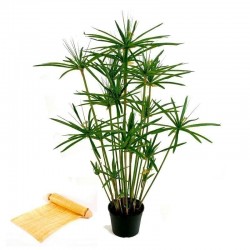
Papyrus Sedge, Paper Reed...
Цена
2,35 €
SKU: MHS 10
Seeds Gallery Com,
5/
5
<!DOCTYPE html>
<html>
<head>
<meta http-equiv="Content-Type" content="text/html; charset=UTF-8" />
</head>
<body>
<h2><strong><em><span style="text-decoration: underline;">Papyrus Sedge, Paper Reed Seeds (Cyperus papyrus)</span></em></strong></h2>
<h3><span style="color: #ff0000;"><strong>Price for Package of 10 seeds. </strong></span></h3>
<p>Cyperus papyrus (papyrus sedge, paper reed, Indian matting plant, Nile grass) is a species of aquatic flowering plant belonging to the sedge family Cyperaceae. It is a tender herbaceous perennial, native to Africa, and forms tall stands of reed-like swamp vegetation in shallow water.</p>
<p>Papyrus sedge (and its close relatives) has a very long history of use by humans, notably by the Ancient Egyptians—it is the source of papyrus paper, one of the first types of paper ever made. Parts of the plant can be eaten, and the highly buoyant stems can be made into boats. It is now often cultivated as an ornamental plant.</p>
<p>In nature, it grows in full sun, in flooded swamps, and on lake margins throughout Africa, Madagascar, and the Mediterranean countries.</p>
<p>C. papyrus and the dwarf cultivar C. papyrus 'Nanus'[3] have gained the Royal Horticultural Society's Award of Garden Merit.</p>
<p>This tall, robust, leafless aquatic plant can grow 4 to 5 m (13 to 16 ft) high. It forms a grass-like clump of triangular green stems that rise up from thick, woody rhizomes. Each stem is topped by a dense cluster of thin, bright green, thread-like stems around 10 to 30 cm (4 to 10 in) in length, resembling a feather duster when the plant is young. Greenish-brown flower clusters eventually appear at the ends of the rays, giving way to brown, nut-like fruits.</p>
<p>The younger parts of the rhizome are covered by red-brown, papery, triangular scales, which also cover the base of the culms. Botanically, these represent reduced leaves, so strictly it is not quite correct to call this plant fully "leafless".</p>
<p><strong>Cultivation</strong></p>
<p>The papyrus plant is relatively easy to grow from seed, though in Egypt, it is more common to split the rootstock, and grows quite fast once established.</p>
<p><strong>Uses</strong></p>
<p>In Ancient Egypt, papyrus was used for various of purposes such as baskets, sandals, blankets, medicine, incense, and boats. The woody root was used to create bowls and different utensils, and was also burned for fuel. Egyptians made efficient use of the entire plant. Papyrus was an important, "Gift of the Nile" which is still preserved and perpetuated in the Egyptian culture.</p>
<p><strong>Papyrus in history</strong></p>
<p>Egyptians used the plant (which they called aaru) for many purposes, most famously for making papyrus. Its name in Greek and in English is widely believed to have come from Egyptian. Cyperus papyrus is now used mainly for decoration, as it is nearly extinct in its native habitat in the Nile Delta, where in ancient times it was widely cultivated. Theophrastus' History of Plants (Book iv. 10) states that it grew in Syria, and according to Pliny's Natural History, it was also a native plant of the Niger River and the Euphrates.</p>
<p>Aside from papyrus, several other members of the genus Cyperus may also have been involved in the multiple uses Egyptians found for the plant. Its flowering heads were linked to make garlands for the gods in gratitude. The pith of young shoots was eaten both cooked and raw. Its woody root made bowls and other utensils and was burned for fuel. From the stems were made reed boats (seen in bas-reliefs of the Fourth Dynasty showing men cutting papyrus to build a boat; similar boats are still made in southern Sudan), sails, mats, cloth, cordage, and sandals. Theophrastus states that King Antigonus made the rigging of his fleet of papyrus, an old practice illustrated by the ship's cable, wherewith the doors were fastened when Odysseus slew the suitors in his hall (Odyssey xxi. 390).</p>
<p>The "rush" or "reed" basket in which the Biblical figure Moses was abandoned may have been made from papyrus.</p>
<p>The adventurer Thor Heyerdahl built two boats from papyrus, Ra and Ra II, in an attempt to demonstrate that ancient African or Mediterranean people could have reached America. He succeeded in sailing Ra II from Morocco to Barbados. Fishermen in the Okavango Delta use small sections of the stem as floats for their nets.</p>
<p><strong>Ecology</strong></p>
<p>Papyrus can be found in tropical rain forests,[where?] tolerating annual temperatures of 20 to 30 °C (68 to 86 °F) and a pH of 6.0 to 8.5. Papyrus flowers in late summer, and prefers full sun to partly shady conditions. Like most tropical plants, it is sensitive to frost. In the United States, it has become invasive in Florida and has escaped from cultivation in Louisiana, California, and Hawaii.</p>
<p>Papyrus sedge forms vast stands in swamps, shallow lakes, and along stream banks throughout the wetter parts of Africa, but it has become rare in the Nile Delta. In deeper waters, it is the chief constituent of the floating, tangled masses of vegetation known as sudd. It also occurs in Madagascar, and some Mediterranean areas such as Sicily and the Levant.</p>
<p>The "feather-duster" flowering heads make ideal nesting sites for many social species of birds. As in most sedges, pollination is by wind, not insects, and the mature fruits after release are distributed by water.</p>
<p>Papyrus is a C4 sedge that forms highly productive monotypic stands over large areas of wetland in Africa.</p>
<h2 style="text-align: center;"><span style="color: #fd0000;"><strong>ATTENTION !!! </strong></span></h2>
<h2 style="text-align: center;"><span style="color: #fd0000;"><strong>SEEDS ARE VERY SMALL, UNPACKING AT THE WHITE PAPER !!!</strong></span></h2>
<p></p>
</body>
</html>
MHS 10 (10 S)

- Только онлайн
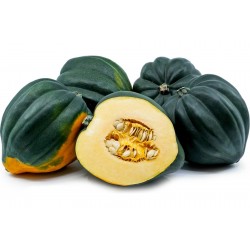
Table Queen Acorn - Сквош...
Цена
2,25 €
SKU: VG 42
Seeds Gallery Com,
5/
5
<h2><strong>Table Queen Acorn - Сквош Семена</strong></h2>
<h2><span style="color:#ff0000;"><strong>Цена за пакет из 10 семян.</strong></span></h2>
<p>Многие новости попадают в огород в этом году, и это одна из них. «Table Queen» - это так называемый Acorn Squash - небольшой плиссированный сквош с темно-зеленой тонкой кожей и желтой вкусной мякотью. Плоды около 0,5-1 кг каждый, что в любом случае, я думаю, хорошего размера. Конечно, это забавно со всей классной, большой зимней тыквой, и они действительно слишком большие. Эту «Королеву столов» иногда также называют «датскими» (не знаю почему) и «Де-Мойн», и в Де-Мойне был поставщик семян, который представил «<strong>Table Queen Acorn</strong>» в 1913 году. Так что это старое наследие</p>
VG 42 (10 S)

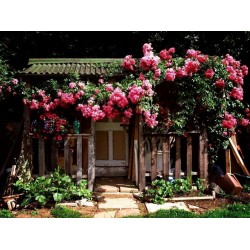
Восхождение Роуз Семена...
Цена
2,50 €
SKU: F 76
Seeds Gallery Com,
5/
5
<!DOCTYPE html>
<html>
<head>
<meta http-equiv="Content-Type" content="text/html; charset=UTF-8" />
</head>
<body>
<h2><strong>Восхождение Роуз Семена "Paul's Scarlet Climber"</strong></h2>
<h2><span style="color: #ff0000;">Цена за пакет из 10 семян.</span></h2>
<p>A valuable cultivar of delicately, sweetly scented, deep red flowers. Healthy, frost and disease resistant.</p>
<p><strong>WHAT IT LOOKS LIKE</strong>: Flowers of deep, nearly claret red, ca. 8 cm across, semi-double, gathered in large inflorescences; subtly scented. Bloom abundantly from June-July till the end of summer. Leaves rather small, composed of small glossy leaflets. Annual shoots are very long – up to 3-4 m – thin and supple, easy to train over supports.</p>
<p><strong>HOW IT GROWS</strong>: A primitive climber – does not climb over supports but leans on them. The height of the plant depends mainly on the support size, in Poland it reaches 3-4 m. The support needs to be large and sturdy.</p>
<p><strong>WHERE TO PLANT</strong>: Sunny sites. Well-adapted to nearly every type of soil, but does not tolerate compacted, heavy or sandy and droughty ground. Thrives in light, moderately permeable soil of slightly acidic or neutral pH. Frost hardy (zone 6-8).</p>
<p><strong>HOW TO APPLY</strong>: The rose can be planted along natural supports, usually trunks of trees with loose, open crowns which allows a higher growth. The cultivar recommended for various types of parks and gardens, in areas designed both in formal (e.g. by the main entrance) and natural style. It can be planted along trellises, gates, walls and fences as well as by pergolas and arbours. It's flexible and easily follows the support's shape.</p>
</body>
</html>
F 76

.png)
Variety from Greece
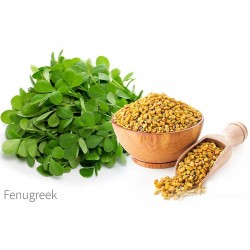
Семена Па́житник сенно́й,...
Цена
1,15 €
SKU: VE 64 (2g)
Seeds Gallery Com,
5/
5
<h2><strong>Семена Па́житник сенно́й, па́житник гре́ческий, шамбала́ (Trigonella foenum-graecum)</strong></h2>
<h2><span style="color: #ff0000;"><strong>Цена за пакет из 140 (2 g) семян.</strong></span></h2>
<p><b>Па́житник сенно́й</b>, или<span> </span><b>па́житник гре́ческий</b>, или<span> </span><b>шамбала́</b><sup id="cite_ref-1" class="reference"></sup><span> </span>(лат. <span lang="la" xml:lang="la">Trigonélla foénum-graécum</span>) —<span> </span>однолетнее<span> </span>растение;<span> </span>вид<span> </span>рода<span> </span>Пажитник<span> </span>семейства<span> </span>Бобовые(подсемейство<span> </span>Мотыльковые).</p>
<p>Произрастает в<span> </span>Восточной Европе, на<span> </span>Кавказе, в гористых местностях<span> </span>Армении,<span> </span>Турции,<span> </span>Ирака,<span> </span>Ирана<span> </span>и<span> </span>Средней Азии, встречается также в<span> </span>Египте<span> </span>и<span> </span>Эфиопии. Культивируется повсеместно. Предпочитает солнечные места произрастания с<span> </span>глинистой<span> </span>почвой.</p>
<h2><span class="mw-headline">Названия</span></h2>
<p>Латинское название<span> </span><i>foenum-graecum</i><span> </span>означает<span> </span><i>греческое сено</i>. Растение также известно как фенугрек (<i>fenugreek</i>), шамбала, хельба (хильба), метхи (<i>methi</i>), чаман<sup id="cite_ref-2" class="reference"></sup><sup id="cite_ref-3" class="reference"></sup>, верблюжья трава<sup id="cite_ref-4" class="reference"></sup>.</p>
<h2><span></span><span class="mw-headline">Ботаническое описание</span></h2>
<div class="thumb tleft">
<div class="thumbinner"><img alt="Семена Па́житник сенно́й, па́житник гре́ческий, шамбала́ (Trigonella foenum-graecum)" src="https://upload.wikimedia.org/wikipedia/commons/thumb/c/ce/Illustration_Trigonella_foenum-graecum0_clean.jpg/220px-Illustration_Trigonella_foenum-graecum0_clean.jpg" width="220" height="363" class="thumbimage" title="Семена Па́житник сенно́й, па́житник гре́ческий, шамбала́ (Trigonella foenum-graecum)">
<div class="thumbcaption">
<div class="magnify"></div>
Ботаническая иллюстрация<span> </span>из книги<span> </span><span class="nowrap">О. В. Томе</span><span> </span><i>Flora von Deutschland, Österreich und der Schweiz</i>, 1885</div>
</div>
</div>
<p>Растение высотой до 60 см с очерёдными тройчатосложными<span> </span>листьями<span> </span>длиной 2 см;<span> </span>листочки<span> </span>яйцеобразные и по краям немного зубчатые.</p>
<p>Стебель<span> </span>ветвистый, округлый,<span> </span>корень<span> </span>стержневой.</p>
<p>Цветки<span> </span>сидячие, по одному — два в пазухах листьев, мотыльковые, очень маленькие, желтовато-белые, а в основании светло-фиолетовые. Растение цветёт с мая до июня.</p>
<p>Из цветков развиваются длинные (до 10 см) узкие (толщиной 4—5 мм) голые или опушённые<span> </span>бобы<span> </span>с твёрдыми прямоугольными<span> </span>семенами.</p>
<h2><span></span><span class="mw-headline">Хозяйственное значение и применение</span></h2>
<div class="thumb tright">
<div class="thumbinner"><img alt="Семена Па́житник сенно́й, па́житник гре́ческий, шамбала́ (Trigonella foenum-graecum)" src="https://upload.wikimedia.org/wikipedia/commons/thumb/5/5a/Fenugreek_seeds%28%E0%A6%AE%E0%A7%87%E0%A6%A5%E0%A6%BF%29.JPG/220px-Fenugreek_seeds%28%E0%A6%AE%E0%A7%87%E0%A6%A5%E0%A6%BF%29.JPG" width="220" height="201" class="thumbimage" title="Семена Па́житник сенно́й, па́житник гре́ческий, шамбала́ (Trigonella foenum-graecum)">
<div class="thumbcaption">
<div class="magnify"></div>
Семена</div>
</div>
</div>
<p>В качестве<span> </span>лекарственного сырья<span> </span>используют семя пажитника сенного (лат. <span lang="la" xml:lang="la">Semen Trigonellae foenum-graeci</span>), собранное в фазе зрелости, содержащее до 1,34 % суммы<span> </span>стероидных сапонинов<span> </span>(диосгенин, тигонин, ямогенин).</p>
<p>Всё растение обладает интенсивным запахом.</p>
<p>Семена пажитника незаменимы для приготовления многих блюд<span> </span>индийской кухни, например,<span> </span>дхала. Молодые побеги используют в качестве<span> </span>приправы<span> </span>к мясным блюдам и в сыроварении. Входят также в состав смеси приправ<span> </span>хмели-сунели<span> </span>и смеси чаман, которой покрывают вяленую мясную вырезку —<span> </span>бастурму. Содержат большое количество<span> </span>галактоманнана, известного под названием «камедь пажитника», который используется как<span> </span>пищевая добавка<span> </span>Е417.</p><script src="//cdn.public.n1ed.com/G3OMDFLT/widgets.js"></script>
VE 64 (2g)


This plant is resistant to winter and frost.

У этого растения гигантские плоды

Гигантские семена кумквата...
Цена
3,25 €
SKU: V 50 G
Seeds Gallery Com,
5/
5
<h2><span style="color:#000000;"><strong>Гигантские семена кумквата (Fortunella margarita)</strong></span></h2>
<h2><span style="color:#ff0000;"><strong>Цена за пакет из 3 семян.</strong></span></h2>
<p>Это гигантский кумкват, который более чем в три раза больше обычного кумквата.</p>
<p><span style="font-size:10pt;">Kumquats or cumquats are a group of small fruit-bearing trees in the flowering plant family Rutaceae, either forming the genus Fortunella, or placed within Citrus sensu lato. The edible fruit closely resembles that of the orange (Citrus sinensis), but it is much smaller and ovular, being approximately the size and shape of an olive. The English name "kumquat" derives from the Cantonese pronunciation gam1 gwat1 (given in Jyutping romanization).</span></p>
<p><span style="font-size:10pt;">They are slow-growing evergreen shrubs or short trees, from 2.5 to 4.5 meters (8 to 15 ft) tall, with dense branches, sometimes bearing small thorns. The leaves are dark glossy green, and the flowers white, similar to other citrus flowers, borne singly or clustered in the leaf-axils. Depending on size, the kumquat tree can produce hundreds or even thousands of fruits each year.[1] The tree can be hydrophytic, with the fruit often found floating on water near shore during the ripe season.[citation needed]</span></p>
<div><span style="font-size:10pt;">The plant is native to south Asia and the Asia-Pacific region. The earliest historical reference to kumquats appears in literature of China in the 12th century. They have long been cultivated in Japan, Taiwan, the Philippines, and southeast Asia. They were introduced to Europe in 1846 by Robert Fortune, collector for the London Horticultural Society, and shortly thereafter into North America.</span></div>
<div><span style="font-size:10pt;">Classification</span></div>
<div><span style="font-size:10pt;">Carl Peter Thunberg originally classified the kumquats as Citrus japonica in his 1784 book Flora Japonica. In 1915, Walter T. Swingle reclassified them in a segregate genus, Fortunella, named in honor of Robert Fortune. Seven species of Fortunella have generally been recognized—F. japonica, F. margarita, F. crassifolia, F. hindsii, F. obovata and F. polyandra, as well as the recently described F. bawangica . The Flora of China returns the kumquat to Citrus and combines the species into the single species as Citrus japonica.[2]</span></div>
<div><span style="font-size:10pt;">Varieties :</span></div>
<div><span style="font-size:10pt;">Round kumquat</span></div>
<div><span style="font-size:10pt;">The round kumquat (also Marumi kumquat or Morgani kumquat) is an evergreen tree, producing edible golden-yellow colored fruit. The fruit is small and usually round but can be oval shaped. The peel has a sweet flavor but the fruit has a sour center. The fruit can be eaten cooked but is mainly used to make marmalade and jelly. It is grown as an ornamental plant and can be used in bonsai. This plant symbolizes good luck in China and other Asian countries, where it is sometimes given as a gift during the Lunar New Year. It's more commonly cultivated than most other kumquats as it is cold tolerant. It can be kept as a houseplant.</span></div>
<div><span style="font-size:10pt;">When the kumquats are divided into multiple species the name Fortunella japonica (Citrus japonica) is retained by this group.</span></div>
<div><span style="font-size:10pt;">Oval kumquat</span></div>
<div><span style="font-size:10pt;">Fortunella margarita, also known as the oval kumquat or the Nagami kumquat, is a close relative to Citrus species. It is a small evergreen tree, that can reach more than 12 ft (4 m) high and 9 ft (3 m) large. It is native to southeastern Asia, and more precisely to China. The oval kumquat has very fragrant citrus-like white flowers, and small edible oval orange fruits. The oval kumquat is an ornamental little tree, with showy foliage, flowers and fruits. It is also fairly frost-hardy, and will withstand negative temperatures such as 14 °F (-10 °C), and even a little lower for very brief periods. It can be grown in USDA hardiness zones 9 and warmer, but can also be tried in sheltered places, in USDA hardiness zone 8. Unlike most citrus species, the oval kumquat has a shorter growth period, and goes into dormancy fairly earlier in autumn. This partly explains its better frost hardiness.</span></div>
<div><span style="font-size:10pt;">Characteristics</span></div>
<div><span style="font-size:10pt;">The evergreen leaves of oval kumquats are deep-green and relatively small. They can reach up to 3 in (7 cm) long and 1.5 in (3.5 cm) wide. The white flowers of the oval kumquat are similar to the citrus flowers. They are strongly perfumed, and they appear relatively late in the growing season, generally late spring.</span></div>
<div><span style="font-size:10pt;">The oval kumquat is a fruit that looks like any citrus fruit, with an orange rind. The fruits are oblong, up to 2 in (5 cm) long. Unlike the common citrus, which have a rind which is inedible raw, oval kumquats have an edible sweet rind. The flesh, however, is not as sweet as the rind, and the juice is quite acidic and sour, with a lemon-like flavor. This fruit is generally eaten fresh, with its rind. It can also be processed into preserves, jams, and other products.</span></div>
<div><span style="font-size:10pt;">Cultivation</span></div>
<div><span style="font-size:10pt;">The oval kumquat needs a well-drained and fertile ground. It dislikes alkaline soils. The oval kumquat is susceptible to common citrus pests and diseases.</span></div>
<div><span style="font-size:10pt;">Jiangsu kumquat</span></div>
<div><span style="font-size:10pt;">The Jiangsu kumquat or Fukushu kumquat bears edible fruit that can be eaten raw. The fruit can be made into jelly and marmalade. The fruit can be round or bell shaped; it is bright orange when fully ripe. It may also be distinguished from other kumquats by its round leaves that make this species unique within the genus. It is grown for its edible fruit and as an ornamental plant. It cannot withstand frost.</span></div>
<div><span style="font-size:10pt;">When the kumquats are divided into multiple species the name Fortunella obovata (Citrus obovata) is used for this group.</span></div>
<div><span style="font-size:10pt;">Cultivation and uses</span></div>
<div><span style="font-size:10pt;">Kumquats are cultivated in China, South Korea, North Korea, Taiwan, Southeast Asia, Japan, the Middle East, Europe (notably Corfu, Greece), southern Pakistan, and the southern United States (notably Florida, Louisiana, Alabama) and California.</span></div>
<div><span style="font-size:10pt;">They are much hardier than other citrus plants such as oranges. The 'Nagami' kumquat requires a hot summer, ranging from 25 °C to 38 °C (77 °F to 100 °F), but can withstand frost down to about −10 °C (14 °F) without injury. They grow in the tea hills of Hunan, China, where the climate is too cold for other citrus fruits, even the Mikan (also known as the Satsuma) orange. The trees differ also from other citrus species in that they enter into a period of winter dormancy so profound that they will remain in it through several weeks of subsequent warm weather without putting out new shoots or blossoms. Despite their ability to survive low temperatures, kumquat trees grow better and produce larger and sweeter fruits in warmer regions.</span></div>
<div><span style="font-size:10pt;">Uses</span></div>
<div><span style="font-size:10pt;">Kumquats are often eaten raw. As the rind is sweet and the juicy center is sour, the raw fruit is usually consumed either whole—to savor the contrast—or only the rind is eaten. The fruit is considered ripe when it reaches a yellowish-orange stage and has just shed the last tint of green.</span></div>
<div><span style="font-size:10pt;">Culinary uses include candying and kumquat preserves, marmalade, and jelly. Kumquats can also be sliced and added to salads. In recent years kumquats have gained popularity as a garnish for cocktail beverages, including the martini as a replacement for the more familiar olive. A kumquat liqueur mixes the fruit with vodka or other clear spirit. Kumquats are also being used by chefs to create a niche for their desserts and are common in European countries.</span></div>
<div><span style="font-size:10pt;">The Cantonese often preserve kumquats in salt or sugar. A batch of the fruit is buried in dry salt inside a glass jar. Over time, all the juice from the fruit is diffused into the salt. The fruit in the jar becomes shrunken, wrinkled, and dark brown in color, and the salt combines with the juice to become a dark brown brine. A few salted kumquats with a few teaspoons of the brine/juice may be mixed with hot water to make a remedy for sore throats.[citation needed] A jar of such preserved kumquats can last several years and still keep its flavor.[citation needed]</span></div>
<div><span style="font-size:10pt;">In the Philippines and Taiwan, kumquats are a popular addition to green tea and black tea, either hot or iced.</span></div>
<div><span style="font-size:10pt;">In Vietnam, kumquat bonsai trees (round kumquat plant) are used as a decoration for the Tết (Lunar New Year) holiday. Kumquat fruits are also boiled or dried to make a candied snack called mứt quất.</span></div>
<div>
<div>
<div>
<table cellspacing="0" cellpadding="0" border="1"><tbody><tr><td colspan="2" width="100%" valign="top">
<p><span style="color:#008000;font-size:10pt;"><strong>Sowing Instructions</strong></span></p>
</td>
</tr><tr><td valign="top" nowrap="nowrap">
<p><span style="color:#008000;font-size:10pt;"><strong>Propagation:</strong></span></p>
</td>
<td valign="top">
<p><span style="color:#008000;font-size:10pt;">Seeds</span></p>
</td>
</tr><tr><td valign="top" nowrap="nowrap">
<p><span style="color:#008000;font-size:10pt;"><strong>Pretreat:</strong></span></p>
</td>
<td valign="top">
<p><span style="color:#008000;font-size:10pt;">0</span></p>
</td>
</tr><tr><td valign="top" nowrap="nowrap">
<p><span style="color:#008000;font-size:10pt;"><strong>Stratification:</strong></span></p>
</td>
<td valign="top">
<p><span style="color:#008000;font-size:10pt;">0</span></p>
</td>
</tr><tr><td valign="top" nowrap="nowrap">
<p><span style="color:#008000;font-size:10pt;"><strong>Sowing Time:</strong></span></p>
</td>
<td valign="top">
<p><span style="color:#008000;font-size:10pt;"> all year round </span></p>
</td>
</tr><tr><td valign="top" nowrap="nowrap">
<p><span style="color:#008000;font-size:10pt;"><strong>Sowing Depth:</strong></span></p>
</td>
<td valign="top">
<p><span style="color:#008000;font-size:10pt;">0.5-1 cm</span></p>
</td>
</tr><tr><td valign="top" nowrap="nowrap">
<p><span style="color:#008000;font-size:10pt;"><strong>Sowing Mix:</strong></span></p>
</td>
<td valign="top">
<p><span style="color:#008000;font-size:10pt;">Coir or sowing mix + sand or perlite</span></p>
</td>
</tr><tr><td valign="top" nowrap="nowrap">
<p><span style="color:#008000;font-size:10pt;"><strong>Germination temperature:</strong></span></p>
</td>
<td valign="top">
<p><span style="color:#008000;font-size:10pt;">min. 20° C.</span></p>
</td>
</tr><tr><td valign="top" nowrap="nowrap">
<p><span style="color:#008000;font-size:10pt;"><strong>Location:</strong></span></p>
</td>
<td valign="top">
<p><span style="color:#008000;font-size:10pt;">bright + keep constantly moist not wet</span></p>
</td>
</tr><tr><td valign="top" nowrap="nowrap">
<p><span style="color:#008000;font-size:10pt;"><strong>Germination Time:</strong></span></p>
</td>
<td valign="top">
<p><span style="color:#008000;font-size:10pt;">Until it Germinates 7days - 2 Months</span></p>
</td>
</tr><tr><td valign="top" nowrap="nowrap">
<p><span style="color:#008000;font-size:10pt;"><strong>Watering:</strong></span></p>
</td>
<td valign="top">
<p><span style="color:#008000;font-size:10pt;">Water regularly during the growing season</span></p>
</td>
</tr><tr><td valign="top" nowrap="nowrap">
<p><span style="color:#008000;font-size:10pt;"><strong> </strong></span></p>
</td>
<td valign="top">
<p><br /><span style="color:#008000;font-size:10pt;">Seeds Gallery 05.11.2012.</span></p>
</td>
</tr></tbody></table></div>
</div>
</div>
V 50 G

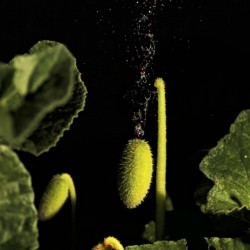
Бе́шеный огуре́ц...
Цена
1,80 €
SKU: PK 7
Seeds Gallery Com,
5/
5
<h2>Бе́шеный огуре́ц обыкнове́нный семена (Ecballium elaterium)</h2>
<h2><span style="color:#ff0000;">Цена за пакет из 5 или 10 семян.</span></h2>
<p><b>Бе́шеный огуре́ц обыкнове́нный</b><span> </span>(лат. <span lang="la" xml:lang="la">Ecballium elaterium</span>) —<span> </span>многолетнее<span> </span>или<span> </span>однолетнее<span> </span>травянистое<span> </span>растение, единственный<span> </span>вид<span> </span>монотипного рода<b>Бешеный огурец</b><span> </span>(<i>Ecballium</i>)<span> </span>семейства<span> </span>Тыквенные<span> </span>(<i><span lang="la" xml:lang="la">Cucurbitaceae</span></i>). Растение известно благодаря своему свойству выбрасывать семена.</p>
<p></p><video width="640" height="320" controls=""><source src="http://i.imgur.com/3TZEsSu.mp4" type="video/mp4"></source></video><p>Ботаническое латинское название рода образовано от<span> </span>др.-греч.<span> </span><span lang="grc" xml:lang="grc"><span>ἐκβάλλω</span></span> —<span> </span><i>выбрасываю</i>, по устройству плода, выбрасывающего семена<sup class="reference"></sup>. Также Бешеным огурцом в России часто ошибочно называют<span> </span>Эхиноцистис<span> </span>неядовитое растение<span> </span>семейства<span> </span>Тыквенные<span> </span>(<i><span lang="la" xml:lang="la">Cucurbitaceae</span></i>).</p>
<p>Распространён на<span> </span>Азорских островах, в<span> </span>Средиземноморье, в<span> </span>Малой Азии, на юге<span> </span>европейской части России, в<span> </span>Крыму, на<span> </span>Кавказе<span> </span>и в<span> </span>Средней Азии.</p>
<p>Произрастает по мусорным местам, залежам, у изгородей по обочинам дорог и на огородах, как сорное по берегу моря, реже на сухих глинистых склонах.</p>
<h2><span class="mw-headline">Ботаническое описание</span></h2>
<table align="right" cellspacing="0" cellpadding="2"><tbody><tr bgcolor="#BBDD99" align="center"><td>
<div class="center">
<div class="floatnone"><img alt="" src="https://upload.wikimedia.org/wikipedia/commons/thumb/0/03/Ecballium_elaterium_CampoCalatrava.jpg/240px-Ecballium_elaterium_CampoCalatrava.jpg" width="240" height="180" /></div>
</div>
</td>
</tr><tr bgcolor="#BBDD99" align="center"><td>
<div class="center">
<div class="floatnone"><img alt="Бе́шеный огуре́ц обыкнове́нный семена (Ecballium elaterium)" src="https://upload.wikimedia.org/wikipedia/commons/thumb/1/1b/Ecballium_elaterium_2.jpg/240px-Ecballium_elaterium_2.jpg" width="240" height="180" title="Бе́шеный огуре́ц обыкнове́нный семена (Ecballium elaterium)" /></div>
</div>
</td>
</tr><tr bgcolor="#BBDD99" align="center"><td>
<div class="center">
<div class="floatnone"><img alt="Бе́шеный огуре́ц обыкнове́нный семена (Ecballium elaterium)" src="https://upload.wikimedia.org/wikipedia/commons/thumb/a/aa/Ecballium_elaterium_flower.jpg/240px-Ecballium_elaterium_flower.jpg" width="240" height="195" title="Бе́шеный огуре́ц обыкнове́нный семена (Ecballium elaterium)" /></div>
</div>
</td>
</tr><tr bgcolor="#BBDD99" align="center"><td>
<div class="center">
<div class="floatnone"><img alt="Бе́шеный огуре́ц обыкнове́нный семена (Ecballium elaterium)" src="https://upload.wikimedia.org/wikipedia/commons/thumb/8/86/Ecballium_flowerdiagrams.png/240px-Ecballium_flowerdiagrams.png" width="240" height="121" title="Бе́шеный огуре́ц обыкнове́нный семена (Ecballium elaterium)" /></div>
</div>
</td>
</tr><tr bgcolor="#BBDD99" align="center"><td>
<div class="center">
<div class="floatnone"><img alt="Бе́шеный огуре́ц обыкнове́нный семена (Ecballium elaterium)" src="https://upload.wikimedia.org/wikipedia/commons/thumb/5/57/Spritzgurke.jpg/240px-Spritzgurke.jpg" width="240" height="160" title="Бе́шеный огуре́ц обыкнове́нный семена (Ecballium elaterium)" /></div>
</div>
</td>
</tr><tr bgcolor="#BBDD99" align="center"><td>
<div>Сверху вниз:<span> </span><br />Общий вид растения.<br />Лист.<br />Цветок.<br />Диаграмма цветков<span> </span><br />(А - мужской, В - женский).<br />Плоды.</div>
</td>
</tr></tbody></table><p>Стебель<span> </span>простёртый или восходящий, без усиков, длиной 50—150 см, с короткими, более-менее шероховатыми веточками.<span> </span>Корень<span> </span>утолщённый, стержневой, слабоветвистый, беловатый, мясистый.</p>
<p>Листья<span> </span>очерёдные, сердцевидно-яйцевидные или слегка лопастные, городчато-зубчатые, длиной 5—10 (до 20) см, шириной 4—8 (до 15) см, снизу серо-войлочные, морщинистые, жестко шероховатые, с утолщенными, выдающимися<span> </span>жилками.<span> </span>Черешки<span> </span>листьев мясистые, вальковатые, щетинисто-шероховатые, длиной 5—15 см.</p>
<p>Цветки<span> </span>однополые,<span> </span>однодомные, очень редко двудомные.<span> </span>Тычиночные<span> </span>цветки на длинных<span> </span>цветоносах<span> </span>в<span> </span>пазушных<span> </span>кистевидныхсоцветиях;<span> </span>цветоложе<span> </span>цветков коротко-колокольчатое;<span> </span>чашелистики<span> </span>в числе пяти, линейно-ланцетные;<span> </span>венчик<span> </span>бледно-жёлтый, широко-колокольчатый или почти колесовидный, глубоко пятираздельный; тычинок пять, из них четыре попарно сросшиеся, одна свободная.<span> </span>Пестичные<span> </span>цветки одиночные, на цветоносах, выходящих обычно из той же листовой пазухи, что и цветоносы тычиночных цветков, с тремя — пятью короткими язычковидными<span> </span>стаминодиями;<span> </span>околоцветник<span> </span>пестичных цветков сходен с таковым у тычиночных;<span> </span>завязь<span> </span>нижняя, продолговатая, щетинистая, с тремя плацентами;<span> </span>столбик<span> </span>короткий, с тремя двураздельными<span> </span>рыльцами. Цветёт в июле — сентябре.</p>
<p>Плоды<span> </span>сизо-зелёные или зелёные, сочные, продолговатые или продолговато-яйцевидные, длиной 4—6 см, шириной 1,5—2,5, колюче-щетинистые, на обоих концах тупые, многосемянные.<span> </span>Семена<span> </span>тёмно-коричневые удлинённые, мелкие, сжатые, гладкие, узко-окаймленные, длиной около 1 см. При созревании семян окружающая их ткань превращается в слизистую массу. При этом в плоде образуется большое давление, в результате чего плод отделяется от плодоножки, а семена вместе со слизью с силой выбрасываются наружу через образовавшееся отверстие. Процесс выбрасывания семян использует<span> </span>реактивное движение. «Выстреливает» свои семена бешеный огурец на расстояние более 6 м. Вес 1000 семян 13—22 г<sup class="reference">[3]</sup>. Плоды созревают в августе — сентябре.</p>
<h2><span></span><span class="mw-headline">Растительное сырьё</span></h2>
<h3><span></span><span class="mw-headline">Заготовка</span></h3>
<p>В качестве лекарственного сырья заготавливают надземную часть и корни растения.</p>
<p>Надземную часть заготавливают во время цветения, стебли разрезают на куски и сушат в солнечную погоду в тени. Сырьё считается готовым, если стебли при сгибании не гнутся, а ломаются. Корни собирают осенью, отряхивают от земли, промывают холодной водой, подвяливают на солнце или в помещении с хорошей вентиляцией и сушат в сушилке или протопленной печи.</p>
<p>Хранят в закрытой посуде 1 год.</p>
<h3><span></span><span class="mw-headline">Химический состав</span></h3>
<p>Растение содержит<span> </span>тритерпеноиды,<span> </span>каротиноиды,<span> </span>стероиды,<span> </span>алкалоиды,<span> </span>органические кислоты,<span> </span>азотсодержащие соединения,<span> </span>витамин С, высшие<span> </span>жирные кислоты<span> </span>и другие вещества. В плодах содержатся элатерин, элатерицин<sup class="reference">[3]</sup>.</p>
<h3><span></span><span class="mw-headline">Целебные свойства</span></h3>
<p>Препараты растения оказывают<span> </span>слабительное,<span> </span>мочегонное,<span> </span>противомалярийное,<span> </span>антигельминтное,<span> </span>антибактериальное<span> </span>и<span> </span>противоопухолевое<span> </span>действие.</p>
<h2><span></span><span class="mw-headline">Значение и применение</span></h2>
<p>Назначают внутрь при<span> </span>отёках,<span> </span>малярии,<span> </span>желтухе новорождённых, воспалительных<span> </span>заболеваниях печени<span> </span>и<span> </span>почек,<span> </span>аменорее,<span> </span>геморрое,<span> </span>злокачественных новообразованиях<span> </span>матки,<span> </span>поносе,<span> </span>подагре,<span> </span>ревматизме,<span> </span>ишиасе,<span> </span>невралгиях, при<span> </span>коликах<span> </span>в<span> </span>кишечнике, наружно при грибковом поражении<span> </span>кожи,<span> </span>трофических язвах,<span> </span>абсцессах, воспалении<span> </span>слизистой оболочки<span> </span>носа<span> </span>и<span> </span>гайморите.</p>
<p>Отвар<span> </span>плодов используют для лечения ревматизма, абсцессов, поносов, воспалительных заболеваний почек, при коликах в кишечнике, геморрое, воспалении слизистой оболочки носа.</p>
<p>В народной медицине и<span> </span>гомеопатии<span> </span>плоды применяют как сильное слабительное средство, при водянке и других застойных явлениях, желтухе новорождённых,<span> </span>перемежающейся лихорадке, ревматизме, ишиасе, невралгиях, подагре, аменорее, а также как противоглистное и мочегонное.</p>
<dl><dt>Медицинские противопоказания</dt>
</dl><p>Растение ядовито, поэтому лечение проводится только по рекомендации и под наблюдением врача. В больших дозах препараты бешеного огурца вызывают тошноту, рвоту, боль в животе, колики, частый пульс.</p>
<h2><span></span><span class="mw-headline">Таксономия</span></h2>
<p>Вид<span> </span><b>Бешеный огурец обыкновенный</b><span> </span>входит в монотипный род<span> </span>Бешеный огурец<span> </span>(<i><span lang="la" xml:lang="la">Ecballium</span></i>)<span> </span>трибы<span> </span><i><span lang="la" xml:lang="la">Benincaseae</span></i><span> </span>подсемейства<span> </span>Тыквенные<span> </span>(<i><span lang="la" xml:lang="la">Cucurbitoideae</span></i>) семейства<span> </span>Тыквенные<span> </span>(<i><span lang="la" xml:lang="la">Cucurbitaceae</span></i>)<span> </span>порядкаТыквоцветные<span> </span>(<i><span lang="la" xml:lang="la">Cucurbitales</span></i>).</p>
PK 7 (5 S)





